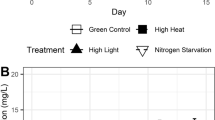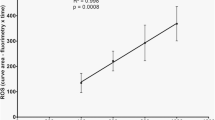Abstract
We investigated a possible relationship between the levels of reactive oxygen species (ROS) and the stimulation of frond division of the aquatic plant Spirodela polyrrhiza (duckweed) during a 7-day experimental culture period. In particular, we monitored superoxide concentration using a state-of-the-art cell biosensor. A considerable reduction in ROS and superoxide concentration was observed during the first 2 days of culture, whereas duckweed cultures achieved near exponential growth rates after the second day. In addition, apoptotic markers such as the cytoplasmic concentration of cytochrome c, mitochondrial membrane depolarization and the activity of caspase-3 declined during the culture period and at least before daughter frond maturation. We suggest that S. polyrrhiza frond division may have been stimulated by the observed reduction of free radicals and the associated avoidance of cell apoptotic pathways in cultured plants.





Similar content being viewed by others
References
van den Bogert C, Muus P, Haanen C, Pennings A, Melis TE, Kroon AM (1988) Mitochondrial biogenesis and mitochondrial activity during the progression of the cell cycle of human leukemic cells. Exp Cell Res 178:143–153
Braeckman BP, Houthoofd K, nemie De Vreese A, Vanfleteren JR (2002) Assaying metabolic activity in ageing Caenorhabditis elegans. Mech Aging Dev 123:105–119
Burdon RH, Gill V, Rice-Evans C (1993) Reduction of a tetrazolium salt and superoxide generation in human tumor cells (HeLa). Free Radic Res Commun 18:369–380
Carol RJ, Takeda S, Linstead P, Durrant MC, Kakesova H, Derbyshire P, Drea S, Zarsky V, Dolan L (2005) A RhoGDP dissociation inhibitor spatially regulates growth in root hair cells. Nature 438:1013–1016
Demple B, Amabile-Cuevas CF (1991) Redox redux: the control of oscillative stress responses. Cell 67:837–839
Doerner PW (1994) Cell cycle regulation in plants. Plant Physiol 106:823–827
Droge W (2002) Free radicals in the physiological control of cell functions. Physiol Rev 82:47–95
Eddy A (1989) Use of carbocyanine dyes to assay membrane potential of mouse ascites tumor cells. Methods Enzymol 172:95–101
Foreman J, Demidchik V, Bothwell JHF, Mylona P, Miedema H, Torresk MA, Linstead P, Costa S, Brownlee C, Jonesk JDG, Davies JM, Dolan L (2003) Reactive oxygen species produced by NADPH oxidase regulate plant cell growth. Nature 422:442–446
Gapper C, Dolan L (2006) Control of plant development by reactive oxygen species. Plant Physiol 141:341–345
Green DR, Reed JC (1998) Mitochondria and apoptosis. Science 281:1309–1312
Guo F-Q, Okamoto M, Crawford NM (2003) Identification of a plant nitric oxide synthase gene involved in hormonal signalling. Science 203:100–103
Hancock JT (2005) Cell signalling. 2nd edn. Oxford University Press, New York pp 278–279
Harman D (1956) Aging: a theory based on free radical and radiation theory. J Gerontol 11:298–300
Harman D (1972) The biologic clock: the mitochondria? J Am Ger Soc 20:145–147
Inzé D, De Veylder L (2006) Cell cycle regulation in plant development. Annu Rev Genet 40:77–105
Kang BG, Cleland CF (1990) Characterization of senescence in Lemna gibba G3: a determinate growth system. Plant Cell Physiol 31:661–665
Kranner I, Beckett RP, Wornik S, Zorn M, Pfeifhofer H (2002) Revival of a resurrection plant correlates with its antioxidant status. Plant J 31:13–24
Kroemer G, Zamzami N, Susin SA (1997) Mitochondrial control of apoptosis. Immunol Today 18:45–51
Kunkel HO, Campbell JE (1952) Tissue cytochrome oxidase activity and body weight. J Biol Chem 198:229–231
LeBel CP, Ischiropoulos H, Bondy SC (1992) Evaluation of the probe 2′,7′-dichlorofluorescein as an indicator of reactive oxygen species formation and oxidative stress. Chem Res Toxicol 5:227–231
Lemon GD, Posluzny U, Husband BC (2001) Potential and realized states of vegetative reproduction in Spirodela polyrhiza, Lemna minor and Wolffia borealis. Aquat Bot 70:79–87
Li PF, Dietz R, von Harsdorf R (1997) Differential effect of hydrogen peroxide and superoxide anion on apoptosis and proliferation of vascular smooth muscle cells. Circulation 96:3602–3609
McLay CL (1976) The effect of pH on the population growth of three species of duckweed: Spirodela oligorhiza, Lemna minor and Wolffia arrihza. Freshw Biol 6:125–136
Moschopoulou G, Kintzios S (2006) Application of “membrane-engineering” to bioelectric recognition cell sensors for the ultra-sensitive detection of superoxide radical: a novel biosensor principle. Anal Chim Acta 573–574:90–96
Neill SJ, Desikan R, Hancock JT (2002) Hydrogen peroxide signaling. Curr Opin Plant Biol 5:388–395
Petrosillo G, Ruggiero FM, Pistolese M, Paradies G (2001) Reactive oxygen species generated from the mitochondrial electron transport chain induce cytochrome c dissociation from beef-heart submitochondrial particles via cardiolipin peroxidation. Possible role in the apoptosis. FEBS Lett 509:435–438
Riou-Khamlichi C, Huntley R, Jacmard A, Murray JAH (1999) Cytokinin activation of Arabidopsis cell division through a D-type cyclin. Science 283:1541–1544
Rodriguez AA, Grunberg KA, Taleisnik EL (2002) Reactive oxygen species in the elongation zone of maize leaves are necessary for leaf elongation. Plant Physiol 129:1627–1632
Schopfer P, Liszkay A, Bechtold M, Frahry G, Wagner A (2002) Evidence that hydroxyl radicals mediate auxin-induced extension growth. Planta 214:821–828
Stomp AM (2005) The duckweeds: a valuable plant for biomanufacturing. Biotechnol Annu Rev 11:69–99
Stöckli B, Brändle R, Erismann KH (1975) Effects of low SO2 concentrations on the mitotic activity and on the cell cycle of duckweed (Spirodela minor L.). Experientia 31:795–796
Suh YA, Arnold RS, Lassegue B, Shi J, Xu X, Sorescu D, Chung AB, Griendling KK, Lambeth JD (1999) Cell transformation by the superoxide-generating oxidase Mox 1. Nature 401:79–82
Toussaint O, Raes M, Remacle J (1991) Aging as a multi-step process characterized by a lowering of entropy production leading the cell to a sequence of defined stages. J Mech Aging Dev 61:45–64
Very AA, Davies JM (2000) Hyperpolarization-activated calcium channels at the tips of Arabidopsis root hairs. Proc Natl Acad USA 97:9801–9806
Xanthoudakis S, Miao G, Wang Pan FY, Curran T (1992) Redox activation of Fos-Jun NA binding activity is mediated by a DNA repair enzyme. EMBO J 11:3323–3335
Xin MG, Zhang J, Block ER, Patel JM (2003) Senescence-enhanced oxidative stress is associated with deficiency of mitochondrial cytochrome c oxidase in vascular endothelial cels. Mech Aging Dev 124:911–919
Yang M, Nazhat NB, Jiang X, Kesley SM, Blake DR, Newland AC, Morris CJ (1996) Adriamycin stimulates proliferation of human lymphoblastic leukaemic cells via a mechanism of hydrogen peroxide (H2O2) production. Br J Haematol 95:339–344
Zeira M, Tosi PF, Mouneimne Y, Lazarte J, Sneed L, Volsky DL, Nikolau C (1991) Full-length CD4 electroinserted in the erythrocyte membrane as a long-lived inhibitor of infection by human immunodeficiency virus. Proc Natl Acad Sci USA 88:4409–4411
Acknowledgments
The authors wish to thank Dr. Federica Brandizzi (MSU-DOE Plant Research Laboratory, Michigan State University) for her valuable comments on the interpretation of the experimental results.
Author information
Authors and Affiliations
Corresponding author
Additional information
Communicated by F. Brandizzi.
Rights and permissions
About this article
Cite this article
Moschopoulou, G., Papanastasiou, I., Makri, O. et al. Cellular redox-status is associated with regulation of frond division in Spirodela polyrrhiza . Plant Cell Rep 26, 2063–2069 (2007). https://doi.org/10.1007/s00299-007-0425-5
Received:
Revised:
Accepted:
Published:
Issue Date:
DOI: https://doi.org/10.1007/s00299-007-0425-5




